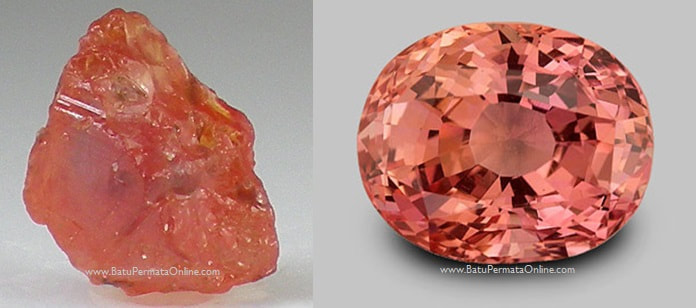the authentic color of Padparadscha Sapphire
An extremely rare and collectible variety that is a mix of pink and orange is known in the trade as padparadscha. Such gems typically have a high value—much higher than many other types of fancy sapphires. Their color can be hard to describe. Some people say padparadscha sapphire colors should be called salmon or sunset. But the word padparadscha itself derives from the Sanskrit language and refers to the rich color of a lotus blossom. Many agree that padparadschas straddles the color boundary between pink and orange.
Padparadscha Sapphire may be a little known to the general public, but they are appreciated by gem lovers. But after decades of debate, collectors, dealers, and jewelers cannot approve uniform standards for the color range of adschas. The fighting points include how pink or how orange the sapphire is, and whether a certain tone is too dark to qualify. Some padparadscha sapphires are salmon-colored evenly, but are rather colored in pink and yellow.
Padparadscha Sapphire may be a little known to the general public, but they are appreciated by gem lovers. But after decades of debate, collectors, dealers, and jewelers cannot approve uniform standards for the color range of adschas. The fighting points include how pink or how orange the sapphire is, and whether a certain tone is too dark to qualify. Some padparadscha sapphires are salmon-colored evenly, but are rather colored in pink and yellow.
Clarity is an important element for Padparadschas because their tone of light easily expresses inclusion. All types of cloudy will make the color of padparadscha become dull. Nevertheless this stone is so rare that consumers may have to sacrifice high clarity to get stones with brilliant colors. The extreme scarcity of rough padparadscha means that cut stones will be formed to save as much material as possible. This also means that padparadschas may have unusual asymmetrical pieces.
Because of the high prices that this rare sapphire command has, many treatments have been developed to create colors like adscha like sapphire. In the late 1990s, the world gem market experienced a sudden flow of sapphires in Padadsadscha. Enthusiastic consumers turned angry when it was discovered that these stones had been colored with radical new treatment methods. When heated to extreme temperatures in the presence of beryllium, poorly colored pink sapphires can appear with beautiful pink orange to pink on the parasads. Beryllium penetrates deep into the sapphire, making it very difficult to detect. Gemologists develop reliable testing procedures for diffusion of beryllium.
Padparadscha sapphires are mainly found in Sri Lanka, as well as Madagascar and Tanzania.
Because of the high prices that this rare sapphire command has, many treatments have been developed to create colors like adscha like sapphire. In the late 1990s, the world gem market experienced a sudden flow of sapphires in Padadsadscha. Enthusiastic consumers turned angry when it was discovered that these stones had been colored with radical new treatment methods. When heated to extreme temperatures in the presence of beryllium, poorly colored pink sapphires can appear with beautiful pink orange to pink on the parasads. Beryllium penetrates deep into the sapphire, making it very difficult to detect. Gemologists develop reliable testing procedures for diffusion of beryllium.
Padparadscha sapphires are mainly found in Sri Lanka, as well as Madagascar and Tanzania.



